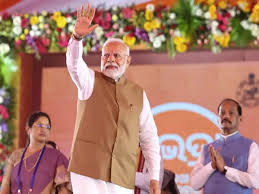
Honorable Prime Minister of India Shri. Narendra Modi unveiled the developmental projects worth Rs. 83,700 crore in Jharkhand. Including the Dharti Aaba Janjatiya Gram Utkarsh Abhiyan for tribal development. He launched this project on the day of Gandhi Jayanti. And also laid the foundation stone for multiple projects.
About Dharti Aaba Janjatiya Gram Utkarsh Abhiyan
Aim : To ensure comprehensive and holistic development for tribal communities across the country.
Implemented Cost of around 79,150 crore.
Beneficiaries as per PMO Source : The project will benefit more than 5 crore tribals in 549 districts across 30 states and Union Territories.
Objective : The scheme seeks to address critical gaps in social infrastructure, health, education, and livelihood through 25 interventions implemented by 17 central ministries and departments.
PM Remarks : The Dharti Aaba Janjatiya Gram Utkarsh Abhiyan with an outlay of around Rs 79.150 crore.
- This scheme will cover around 63,000 tribal villages for their development. It will benefit more than 5 crore people.
- I am happy that this scheme is starting from the land of Bhagwan Birsa Munda.
PM Janjati Adivasi Nyaya Maha Abhiyan (PM-JANMAN)
- PM also inaugurated and laid the foundation stones for multiple projects under the PM Janjati Adivasi Nyaya Maha Abhiyan (PM-JANMAN),
- The scheme is valued at over Rs 1,360 crore.
- These include the construction of more than 1,380 km of roads, 120 anganwadi centers , 250 multi-purpose centers, and 10 school hostels.
About PM-JANMAN
- PM-JANMAN (comprising Central Sector and Centrally Sponsored Schemes) was launched for the socio-economic welfare of PVTGs on 15th November 2023 in Khunti, Jharkhand, on the occasion of Janjatiya Gaurav Diwas.
- PM-JANMAN, with a budget of approximately Rs 24,000 crore, focuses on 11 critical interventions through 9 Ministries.
Aim : To improve socio-economic conditions of the PVTGs by saturating PVTG households and habitations with basic facilities such as safe housing, clean drinking water and sanitation, electricity, road and telecom connectivity etc.
Numbers : India has a Scheduled Tribes population of 10.45 crore as per 2011 census, out of which 75 communities located in 18 States and the Union Territory of Andaman and Nicobar Islands have been categorized as PVTGs.
What are PVTGs?
- PVTGs are more vulnerable among the tribal groups.
- Due to this factor, more developed and assertive tribal groups take a major chunk of the tribal development funds, because of which PVTGs need more funds directed for their development.
- In this context, in 1975, the Government of India declared 52 tribal groups as PVTGs on the recommendation of the Dhebar Commission.
- Currently, there are 75 PVTGs out of 705 Scheduled Tribes.
- The PVTGs are spread over 18 states and one Union Territory (UT), in the country (2011 census).
- Odisha has the highest number (more than 2.5 lakh) of PVTGs.
Other announcements by PM
- The Prime Minister announced the electrification of over 75,800 households belonging to Particularly Vulnerable Tribal Groups (PVTG) in around 3,000 villages.
- Other initiatives include the operationalisation of 275 mobile medical units, 500 anganwadi centers, establishment of 250 Van Dhan Vikas Kendras, and the provision of piped water (Nal se Jal) to more than 5,550 PVTG villages.
- To bolster educational infrastructure for tribal communities, the Prime Minister will also inaugurate 40 Eklavya Model Residential Schools (EMRS) and lay the foundation stone for an additional 25 EMRS worth over Rs 2,800 crore.
Info about EMRS
- EMRS is a scheme for making model residential schools for Indian tribals (ST- Scheduled Tribes) across India. It started in the year 1997-98.
- The Eklavya Model Residential School in Shinde (Nashik) has been planned by the Ministry Tribal Affairs to give impetus to quality education in nearby tribal areas.
- The EMR School follows the CBSE curriculum.
- Eklavya Model Residential Schools are being developed to impart quality education to tribal students, with an emphasis on not only academic education but all-round development of tribal students.





